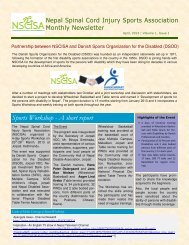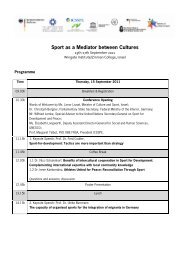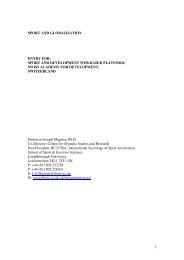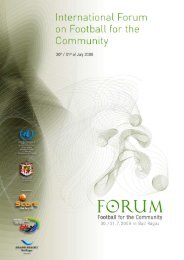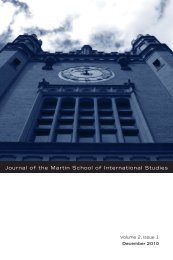The contribution of sport within the process - International Platform ...
The contribution of sport within the process - International Platform ...
The contribution of sport within the process - International Platform ...
You also want an ePaper? Increase the reach of your titles
YUMPU automatically turns print PDFs into web optimized ePapers that Google loves.
<strong>of</strong> peace promotion, children's rights & education, health promotion, anti-discrimination<br />
& social integration, and <strong>the</strong> environment. <strong>The</strong>se programmes must be aimed at<br />
children and young people, and use football as an instrument to promote participation<br />
and dialogue. <strong>The</strong> aim <strong>of</strong> Football for Hope is to create a better future through <strong>the</strong><br />
medium <strong>of</strong> football.<br />
A simple answer to some <strong>of</strong> <strong>the</strong> problems behind war and towards reconciliation<br />
is that people need to find a common ground, and <strong>the</strong>y need to do it from a young and<br />
impressionable age. Encouraging participation in football for peace projects is one<br />
natural and viable way to steadily plant <strong>the</strong> seeds <strong>of</strong> peace. <strong>The</strong> Office <strong>of</strong> <strong>the</strong> United<br />
Nations High Commissioner for Refugees (UNHCR) has long been using <strong>the</strong> power <strong>of</strong><br />
football, among o<strong>the</strong>r <strong>sport</strong>s, in its programmes and policies to facilitate refugee<br />
reintegration and to ensure tolerance and understanding between and <strong>within</strong> war-<br />
conflicted communities.<br />
Borsani Serena – Master in Human Rights and Conflict Management 2008<br />
Dissertation<br />
33<br />
CHAPTER 4: CASE STUDY - THE IMPACT OF SPORT<br />
INTERVENTIONS IN RIFT VALLEY-KENYA, AFTER POST ELECTION<br />
VIOLENCE<br />
4.1 KENYA PROFILE – AT A GLANCE<br />
Table 2 – Kenya pr<strong>of</strong>ile<br />
Full name: <strong>The</strong> Republic <strong>of</strong> Kenya<br />
Population: 38.5 million (UN, 2008)<br />
Capital: Nairobi<br />
Government Semi-presidential Republic<br />
- President Mwai Kibaki<br />
- Prime Minister Raila Odinga<br />
Independence From <strong>the</strong> United Kindom<br />
- date December 12, 1963<br />
- Republic declared December 12, 1964<br />
Area: 582,646 sq km (224,961 sq miles)<br />
Major languages: Swahili, English<br />
Major religion: Christianity<br />
Life expectancy: 53 years (men), 55 years (women) (UN)<br />
Ethnicity Majority <strong>of</strong> kikuyu, followed by luya, luo and kalenjin<br />
Monetary unit: 1 Kenya shilling = 100 cents<br />
Main exports: Tea, c<strong>of</strong>fee, horticultural products, petroleum products<br />
GNI per capita: US $680 (World Bank, 2007)<br />
Figure 7 - Ethnicity distribution<br />
Borsani Serena – Master in Human Rights and Conflict Management 2008<br />
Dissertation<br />
Figure 6 - Kenya map<br />
34



